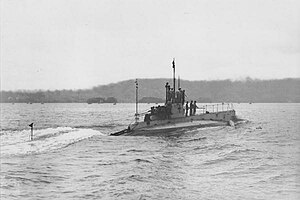Ha-3 class submarine

Japanese submarine Ha-3, in August 1911
|
|
| Class overview | |
|---|---|
| Builders: | Vickers, Barrow-in-Furness, UK |
| Operators: |
|
| Preceded by: | Ha-1 class submarine |
| Succeeded by: | Ha-7 class submarine |
| In commission: | 1911–1929 |
| Completed: | 3 |
| Retired: | 3 |
| General characteristics | |
| Type: | Submarine |
| Displacement: |
|
| Length: | 43.3 m (142 ft) |
| Beam: | 4.14 m (13.6 ft) |
| Draft: | 3.43 m (11.3 ft) |
| Installed power: |
|
| Propulsion: |
|
| Speed: |
|
| Range: |
|
| Test depth: | 30.5 metres (100 ft) |
| Complement: | 26 officers and enlisted |
| Armament: |
|
The Ha-3 class submarine (波三型潜水艦 Ha-san-gata sensuikan) was an early class of submarines of the Imperial Japanese Navy.
Along with placing orders with Vickers at Barrow-in-Furness in the UK for two British C class submarines, which were commissioned into the Imperial Japanese Navy as the Ha-1 class, the Japanese government ordered another three vessels, which were received as knock-down kits. These kits were assembled at the Kure Naval Arsenal.
Physically almost identical to the Ha-1 class, the three vessels assembled in Japan incorporated a number of improvements, including extended bow for improved seaworthiness, improved rudder for surface handling, and an increase in the size of the bridge and conning tower.
...
Wikipedia
